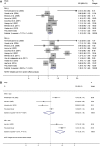Dialysis Modality and Mortality in the Elderly: A Meta-Analysis
- PMID: 25941194
- PMCID: PMC4455206
- DOI: 10.2215/CJN.05160514
Dialysis Modality and Mortality in the Elderly: A Meta-Analysis
Abstract
Background and objectives: Identifying the appropriate choice between hemodialysis (HD) and peritoneal dialysis (PD) is an unresolved issue in elderly patients with ESRD, who are at high risk for death but have a low chance of receiving kidney transplantation.
Design, setting, participants, & measurements: Data on 13,065 incident dialysis Korean patients (age≥65 years) receiving HD (n=10,675) or PD (n=2390) were obtained from the Korean Health Insurance dataset. Multiple statistical approaches, including the multivariate Cox model, were used to compare mortality between Korean patients receiving PD and those receiving HD. Subsequently, meta-analysis of previous comparison studies (published since the year 2000; population-based studies) and the Korean dataset was performed.
Results: During a mean duration of 1.8±1.3 years (maximum of 5 years), the Korean PD group had a higher mortality rate than the Korean HD group (hazard ratio [HR], 1.20 [95% confidence interval (95% CI), 1.13 to 1.28]; P<0.001 by multivariate Cox model). The discrepancy between the two modalities was greater in the presence of certain conditions, such as diabetes mellitus or longer dialysis duration. In the meta-analysis, 15 studies involving >631,421 elderly patients were reviewed. Compared with HD, the pooled HR with PD was 1.10 (95% CI, 1.01 to 1.20). When the meta-analysis was stratified by confounding factors, the survival benefit from HD was particularly strong in subgroups that had diabetes mellitus, had long dialysis duration (>1 year), or contained cohorts starting dialysis in the 1990s.
Conclusions: A meta-analysis that included results in Korean patients suggests a higher risk for death in elderly patients receiving PD than in those receiving HD.
Keywords: dialysis modality; elderly; hemodialysis; mortality; peritoneal dialysis.
Copyright © 2015 by the American Society of Nephrology.
Figures





Comment in
-
Mortality in the Elderly on Dialysis: Is This the Right Debate?Clin J Am Soc Nephrol. 2015 Jun 5;10(6):920-2. doi: 10.2215/CJN.03650415. Epub 2015 May 4. Clin J Am Soc Nephrol. 2015. PMID: 25941195 Free PMC article. No abstract available.
References
-
- Locatelli F, Del Vecchio L, Manzoni C: Morbidity and mortality on maintenance haemodialysis. Nephron 80: 380–400, 1998 - PubMed
-
- Schieppati A, Remuzzi G: Chronic renal diseases as a public health problem: Epidemiology, social, and economic implications. Kidney Int Suppl 98: S7–S10, 2005 - PubMed
-
- Collins AJ, Foley RN, Gilbertson DT, Chen SC: The state of chronic kidney disease, ESRD, and morbidity and mortality in the first year of dialysis. Clin J Am Soc Nephrol 4[Suppl 1]: S5–S11, 2009 - PubMed
Publication types
MeSH terms
LinkOut - more resources
Full Text Sources
Medical

